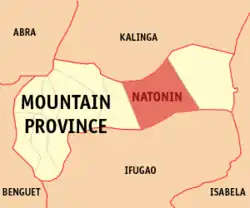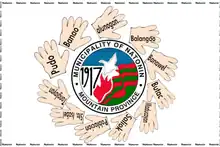Natonin
Natonin, officially the Municipality of Natonin, is a 4th class municipality in the province of Mountain Province, Philippines. According to the 2020 census, it has a population of 10,339 people.[3]
Natonin | |
|---|---|
| Municipality of Natonin | |
.png.webp) Flag  Seal | |
 Map of Mountain Province with Natonin highlighted | |
OpenStreetMap | |
.svg.png.webp) Natonin Location within the Philippines | |
| Coordinates: 17°06′32″N 121°16′47″E | |
| Country | Philippines |
| Region | Cordillera Administrative Region |
| Province | Mountain Province |
| District | Lone district |
| Founded | 1915 |
| Barangays | 11 (see Barangays) |
| Government | |
| • Type | Sangguniang Bayan |
| • Mayor | Jose T. Agagon |
| • Vice Mayor | Raymundo L. Lapasen |
| • Representative | Maximo Y. Dalog Jr. |
| • Municipal Council | Members |
| • Electorate | 8,191 voters (2022) |
| Area | |
| • Total | 252.00 km2 (97.30 sq mi) |
| Elevation | 831 m (2,726 ft) |
| Highest elevation | 1,879 m (6,165 ft) |
| Lowest elevation | 276 m (906 ft) |
| Population (2020 census)[3] | |
| • Total | 10,339 |
| • Density | 41/km2 (110/sq mi) |
| • Households | 2,280 |
| Economy | |
| • Income class | 4th municipal income class |
| • Poverty incidence | 23.07 |
| • Revenue | ₱ 105.1 million (2020) |
| • Assets | ₱ 164.7 million (2020) |
| • Expenditure | ₱ 98.73 million (2020) |
| • Liabilities | ₱ 110.3 million (2020) |
| Service provider | |
| • Electricity | Mountain Province Electric Cooperative (MOPRECO) |
| Time zone | UTC+8 (PST) |
| ZIP code | 2624 |
| PSGC | |
| IDD : area code | +63 (0)74 |
| Native languages | Balangao Bontoc Ilocano Tagalog |
Geography
Natonin is bordered by Kalinga to the north, Paracelis to the east, Barlig to the west, and Ifugao to the south. The barangays are mostly carved at the foot of the mountains along which the now National Highway was carved with the exception Barangay Maducayan and some far-flung sitios of Barangay Banawel.
Natonin is 72 kilometres (45 mi) from Bontoc and 464 kilometres (288 mi) from Manila.
Barangays
Natonin is politically subdivided into 11 barangays. Each barangay consists of puroks and some have sitios.
- Alunogan
- Balangao
- Banao
- Banawel
- Butac
- Maducayan
- Poblacion
- Saliok
- Santa Isabel
- Tonglayan
- Pudo
Climate
| Climate data for Natonin, Mountain Province | |||||||||||||
|---|---|---|---|---|---|---|---|---|---|---|---|---|---|
| Month | Jan | Feb | Mar | Apr | May | Jun | Jul | Aug | Sep | Oct | Nov | Dec | Year |
| Average high °C (°F) | 20 (68) |
21 (70) |
23 (73) |
26 (79) |
26 (79) |
26 (79) |
25 (77) |
25 (77) |
24 (75) |
23 (73) |
22 (72) |
20 (68) |
23 (74) |
| Average low °C (°F) | 14 (57) |
15 (59) |
16 (61) |
17 (63) |
18 (64) |
18 (64) |
18 (64) |
18 (64) |
18 (64) |
18 (64) |
17 (63) |
16 (61) |
17 (62) |
| Average precipitation mm (inches) | 103 (4.1) |
73 (2.9) |
49 (1.9) |
38 (1.5) |
141 (5.6) |
144 (5.7) |
172 (6.8) |
181 (7.1) |
155 (6.1) |
148 (5.8) |
147 (5.8) |
208 (8.2) |
1,559 (61.5) |
| Average rainy days | 17.1 | 12.8 | 11.0 | 9.6 | 18.9 | 21.5 | 23.5 | 24.5 | 21.7 | 16.1 | 17.1 | 20.5 | 214.3 |
| Source: Meteoblue (modeled/calculated data, not measured locally)[5] | |||||||||||||
Demographics
|
|
| |||||||||||||||||||||||||||||||||||||||||||||||||||
| Source: Philippine Statistics Authority[6][7][8][9] | |||||||||||||||||||||||||||||||||||||||||||||||||||||
The locals of Natonin are generally called iNatonin. By ethnolinguistics, the majority of the locals belong to the tribe Balangaos, or Iferangao, and speak the Finerangao language. However, there are two sub-tribes: the Hakki, who inhabit the western part of the town, and the Majukayong (the people are called iMajukayongs), who inhabit the barangays of Saliok and Maducayan. The iMajukayongs are closely related to the Ga'dang people of Paracelis, and speak the iMajukayong dialect which has similarities to the dialects of the iKalingas. Populations of the town are of Igorot lineage. Headhunting was practiced throughout Natonin as late as the mid-1930s, but was set aside in favor of Christianity and education after World War II.
Languages
Natonin is home to two indigenous dialects which have existed there since before the arrival of the Spanish: the Balangaw dialect and the Majukayong dialect. Immigrants from the Ilocos Region came in the 1970s and imported the Ilokano dialect during the era of martial law.
Economy
The primary crop is rice, although limited arable space, mechanization and innovative agriculture renders the harvest to a subsistence level only. Backyard piggery mostly produce the pork supply. Vegetable gardening, fruit tree growing and tilapia raising are also starting to see commercial viability. Whatever is of shortage or lacking are imported outside the municipality. Few local handicrafts are promoted and are only made to order.
Government
Local government

Natonin, belonging to the lone congressional district of the province of Mountain Province, is governed by a mayor designated as its local chief executive and by a municipal council as its legislative body in accordance with the Local Government Code. The mayor, vice mayor, and the councilors are elected directly by the people through an election which is being held every three years.
Elected officials
Members of the Municipal Council (2019–2022):[17]
- Congressman: Maximo Y. Dalog Jr.
- Mayor: Jose T. Agagon
- Vice-Mayor: Raymundo L. Lapasen
- Councilors:
- Rafael Bulawe
- Jose F. Biangalen
- Leon Pangsiw
- Jimmy G. Todco
- Fernandez Linggayo
- Jerry N. Chumilang
- Fernando Magranga Jr.
- Oscar Fangonon
Transportation
Since the widening of the national highways started in 2010, the Paracelis-Natonin Road is paved now. Although, some parts are either eroded or slipping away, and during rainy seasons landslides can render the roads impassable. Public utility or for-hire vans are the easiest transportation either to and from the municipality (e.g. Baguio and Manila).
Tourism
Though it's not yet that improved, Natonin has the following sites:
- The Legendary Silent Mountain of Finaratan, located in Barangay Maducayan.
- The Apatan Rice Terraces
- The Balococ Waterfall
- The Naropaan Waterfall
- Tonglayan Rice Terraces
- Lagan River in Balangao
- Penadna Waterfalls
- Lettalet Waterfalls
- Fuyoun Spring in Siffu River located at Brgy. Saliok
- Elephant Head located in Banao
References
- Municipality of Natonin | (DILG)
- "2015 Census of Population, Report No. 3 – Population, Land Area, and Population Density" (PDF). Philippine Statistics Authority. Quezon City, Philippines. August 2016. ISSN 0117-1453. Archived (PDF) from the original on May 25, 2021. Retrieved July 16, 2021.
- Census of Population (2020). "Cordillera Administrative Region (CAR)". Total Population by Province, City, Municipality and Barangay. Philippine Statistics Authority. Retrieved 8 July 2021.
- "PSA Releases the 2018 Municipal and City Level Poverty Estimates". Philippine Statistics Authority. 15 December 2021. Retrieved 22 January 2022.
- "Natonin: Average Temperatures and Rainfall". Meteoblue. Retrieved 8 March 2020.
- Census of Population (2015). "Cordillera Administrative Region (CAR)". Total Population by Province, City, Municipality and Barangay. Philippine Statistics Authority. Retrieved 20 June 2016.
- Census of Population and Housing (2010). "Cordillera Administrative Region (CAR)". Total Population by Province, City, Municipality and Barangay. National Statistics Office. Retrieved 29 June 2016.
- Censuses of Population (1903–2007). "Cordillera Administrative Region (CAR)". Table 1. Population Enumerated in Various Censuses by Province/Highly Urbanized City: 1903 to 2007. National Statistics Office.
- "Province of Mountain Province". Municipality Population Data. Local Water Utilities Administration Research Division. Retrieved 17 December 2016.
- "Poverty incidence (PI):". Philippine Statistics Authority. Retrieved December 28, 2020.
- "Estimation of Local Poverty in the Philippines" (PDF). Philippine Statistics Authority. 29 November 2005.
- "2003 City and Municipal Level Poverty Estimates" (PDF). Philippine Statistics Authority. 23 March 2009.
- "City and Municipal Level Poverty Estimates; 2006 and 2009" (PDF). Philippine Statistics Authority. 3 August 2012.
- "2012 Municipal and City Level Poverty Estimates" (PDF). Philippine Statistics Authority. 31 May 2016.
- "Municipal and City Level Small Area Poverty Estimates; 2009, 2012 and 2015". Philippine Statistics Authority. 10 July 2019.
- "PSA Releases the 2018 Municipal and City Level Poverty Estimates". Philippine Statistics Authority. 15 December 2021. Retrieved 22 January 2022.
- "2019 National and Local Elections" (PDF). Commission on Elections. Retrieved March 13, 2022.